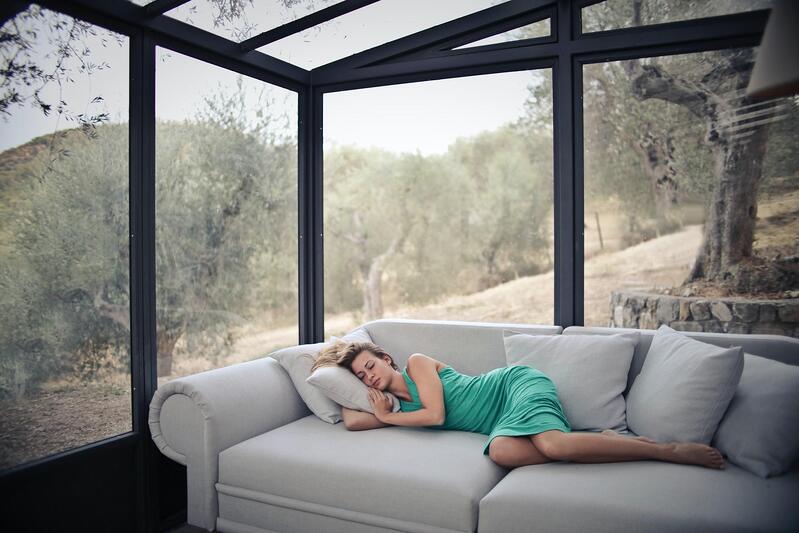DreamWear Mask Review
One of the biggest complaints about using a CPAP machine is how uncomfortable wearing a mask can be or how claustrophobic the mask makes you feel — none of which helps you in your attempt at a good night’s rest.
The newer models of pillow masks have attempted to eliminate the discomfort traditional masks can cause. Most nasal pillow systems have no gear that crosses the front of the bridge of your nose like a traditional mask.
Instead, pillow masks use two soft silicone shaped “pillows” that you insert into each nostril. Pillow masks can help you achieve a better seal — which means you get a better quality of air flow — since there is less material for you to have to adjust and less surface area that needs to hold a seal.
Philips Respironics new mask, the DreamWear, builds on the idea of pillow masks by removing the need to insert anything into your nose. You get the benefits of a nasal and a pillow mask all while having barely anything touch your face. In fact, you may feel like you are not even wearing a mask.
Innovative Design
Some of the biggest complaints about CPAP masks are that they are bulky, leak air, are irritating, and make it hard to move around at night.
The DreamWear mask is designed to combat the top complaints of full-face masks. To begin, the DreamWear mask is designed to be less bulky so you can sleep more comfortably.
DreamWear is designed to be a minimal contact mask just like a pillow mask. That means the mask touches the least amount of your face compared to other masks.
Minimal contact reduces the irritation your skin feels while giving you the freedom to move around as you sleep. The DreamWear masks features a cushion that rests under your nose and seals both nostrils without having to cover the entire nose or insert anything into your nostrils.
Worried about dryness and irritation? The under-the-nose cushion helps to eliminate the irritation and dryness that is caused by most nasal pillow, nasal, and full-face masks.
How about the discomfort of a mask sitting on your face? The mask is designed to sit on your checks as gently as possible. DreamWear’s soft silicone frame and fabric wraps help to ensure you are comfortable so you can sleep soundly while using your CPAP machine.
Hose and frame design

The DreamWear combats the restrictiveness on how you sleep. Less bulk and less tubing gives you the freedom to sleep in any position you would like to. With the DreamWear, you can comfortable sleep on your stomach, side, back, or all three without having to worry about the discomfort of sleeping on a tube.
Another complaint about full-face masks is that you can’t do anything but sleep once you are wearing it. The minimal tubing with the hose connecting at the top of your head means that you have a clear line of sight in case you want to read as you fall asleep or if you need to wear your glasses while you have your CPAP running.
The DreamWear is designed with the elbow that connects the tubing to the mask at the top of the head. The top of the head design allows the hose to be situated for greater comfort without the hose becoming tangled of the mask cushion to shift and leak air.
The mask frame is designed to let the air flow the tubing to reach the nasal cushion. The frame is a single piece that seamlessly connects with the hose elbow, headgear, and nasal cushion.
The hose elbow is designed to be free to swivel inside the connection so you don’t feel like you have to hamper your movement will you sleep. If one side of the DreamWear frame gets closed from you lying on it, air can still flow to the other side without negatively affecting your CPAP pressure.

If you’re worried about how the mask will fit, DreamWear frames and cushions are interchangeable so you can match the right size frame for you with any size cushion.
The DreamWear nasal mask will work with any CPAP or BiPAP machine with standard CPAP tubes. No special adaptors are needed to connect the DreamWear mask to your machine.
Why it might not be for everyone
The DreamWear mask and other pillow masks might not be for you. Pillow masks are often not ideal for patients who need high pressure.
The airflow to a pillow mask is direct and may cause discomfort with higher-pressure settings. The direct flow of high-pressure air could lead to your nose feeling dry and you might even experience nosebleeds.
The pillow mask is not for you if you breathe through your mouth. Pillow masks only work if you are consistently breathing through your nose as you sleep.
If you’re a mouth breather, you may feel liking breathing through your nose is unnatural and uncomfortable.
The other options for CPAP masks are nasal masks and full-face CPAP masks. Nasal masks deliver a more natural airflow than the pillow mask since the pressure isn’t as direct. So if you are using high pressure, you might consider wearing a nasal mask.
Nasal masks and pillow masks are both the best options if you move around a lot in your sleep or you sleep on your side.
If you’re a mouth breather, nasal masks are also not for you. Nasal masks are not ideal if you suffer from allergies or frequent colds that prevent you from breathing through your nose. Nasal masks also present a problem if you can’t breath through your nose because of a nasal blockage like a deviated septum.
So what are you to do if you can’t wear pillow or nasal masks? Full-face masks are best suited for you if you sleep on your back, are a mouth breather, or have a nasal obstruction or frequent congestion.
If you’re claustrophobic, you might not be able to tolerate the extra material and weight of the full mask. Full masks also come with a higher chance of air leaking; and with air leakage, your eyes might become dry and irritated.
Full-face masks can make it more difficult to move around in your sleep. The DreamWear mask may be ideal for you if you can breathe through your nose and don’t use high pressure.
Try out a mask that doesn’t feel like your wearing a mask at all, call Alaska Sleep Clinic so we can help you find the right mask and the correct fit.





